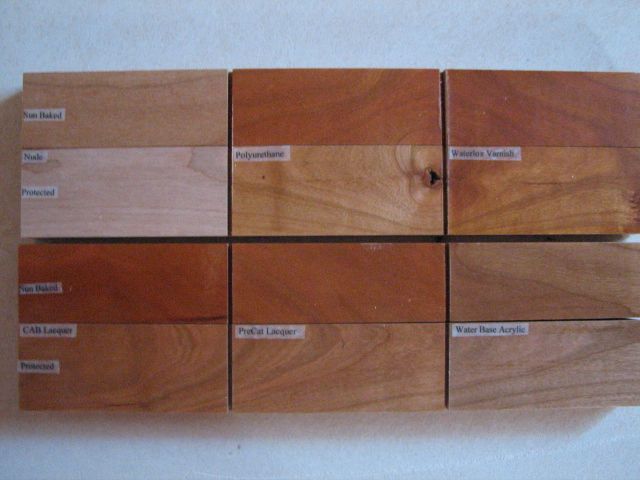Refinishing a Conference Table
A discussion about the challenges and potential pitfalls of restoring a high-build finish on a business conference table.June 16, 2014
Question
A neighboring business has a conference table with some scratches and some dullness in the finish. The deepest scratches I can barely catch with my fingernail. The finish is high-build, so I'm guessing it's polyester or 2K polyurethane. If I take the job my thoughts are to do a healthy amount of sanding to eliminate the scratches, but not get down to the dye/stain, and then spray 2K urethane over the top. I have no idea what it's been cleaned/contaminated with in the past. It was in their main office and then was brought to this locale. The question now is, is this possible? Whether it's worth it, etc., are questions after this one is decided.
Forum Responses
(Finishing Forum)
From contributor K:
Yes itís very possible. In fact, Iíve done quite a few myself. As a precaution I always start out by using a good wax/grease/silicone remover to take off any unwanted contaminants. Be very thorough with this. Wipe behind with clean rags. Turn your rag frequently and donít be afraid to clean the whole thing a couple times. Then I sand it down and clean it again with the wax remover. Then I use a nice coat Zinser Bullseye shellac as a barrier coat if existing finish is unknown. Then proceed as usual with whatever coating you prefer.
From contributor P:
If the existing finish is truly high-build and the scratches aren't deep, why not try very fine sanding and buffing first? Thereís nothing to lose except a little time.
From contributor G:
That's what I was thinking too. Start out with sanding at around 600 grit and bring it up to 2000 grit. Then buff it out. By doing it this way you won't have to worry about interactions with silicones or waxes. If you can't get a satisfactory result then you are halfway there to do the refinishing. You may want to de-wax and remove the possible silicones before you start the process just in case you have to do the refinish.
From contributor R:
A little job like helping a neighboring business like that can turn into a nightmare in a second. You don't know the existing finish, thickness of the finish, what they cleaned it with, on and on. You get the table in your shop, sand it down and get a little burn through in a spot. Then you touch it up. Then you hit it with the first coat and all hell breaks loose. Finish doesn't stick, or fish eyes, blushes, or who knows what else. Now you have a real mess and your neighbor wants a table back. You end up stripping it down to bare wood and then try to do a color match. This is played over and over in many shops that are not experienced with refinishing. Next thing you know you are now paying for the work because you didn't expect nearly that amount of work on the estimate. I stopped doing that kind of work years ago. Any refinishing is like walking into a mine field!
From the original questioner:
I understand Contributor R. I've taken shrapnel before. I usually paint enough of a horror story of what might happen to their invoice that most are scared off.
From contributor R:
Just going off of experience. In this case, it's a rare business owner that knows what the cleaning crew uses on the entire history of his tables. Same has gone on for me with residential. Most people might know what they used for the last couple of years, but not the entire life. Now it seems like more cleaning companies are working in residential - even more hazards there. Iím just warning that the simple jobs are the ones that seem to bite the hardest. Glad you don't have surprises with your refinishing, or the answers you get from your customers.
From Contributor E:
I totally agree that the simplest looking project can and usually turn into a major pain. When you walk into the situation armed with experience and knowledge and then explain to the customer, ďyea it looks like all we do is spray this thing, but it doesn't work like that.Ē
I would scrub it with steel wool and tons of rags, sand it down, scrub it again and proceed with a finish. I must say I don't know squat about 2K urethane, so I don't know if fisheye eliminator is compatible with it. I would use Krystal and the fisheye just to be safe. I know I'll get flamed for advocating fisheye eliminator but Iíve been using it for 20 plus years with no problem.
From Contributor J:
I agree with the multiple scrub-down, but with scotch-brite vs. steel wool owing to the oil in the wool. Scrub with solvents (VMP Naptha/mineral spirits/commercial de-waxer) then with some water type emulsifier/surfactant (oil soap (potassium oleate)/Dawn) and a clean rinse. If the scratches are light and the build deep could you simply compound the top?
From contributor S:
Does anyone use solvents and rubbing pads anymore? If the top just needs a refresh and small scratches removed I would start with a rubbing pad and something like Mohawk Amalgamator or Lacover. No stripping, sanding, refinishing and you can do it in the office where it sits. Youíd probably be done in a couple hours at most depending on size. You'll know right away if it is not going to work on the unknown coating, but most likely it will.
